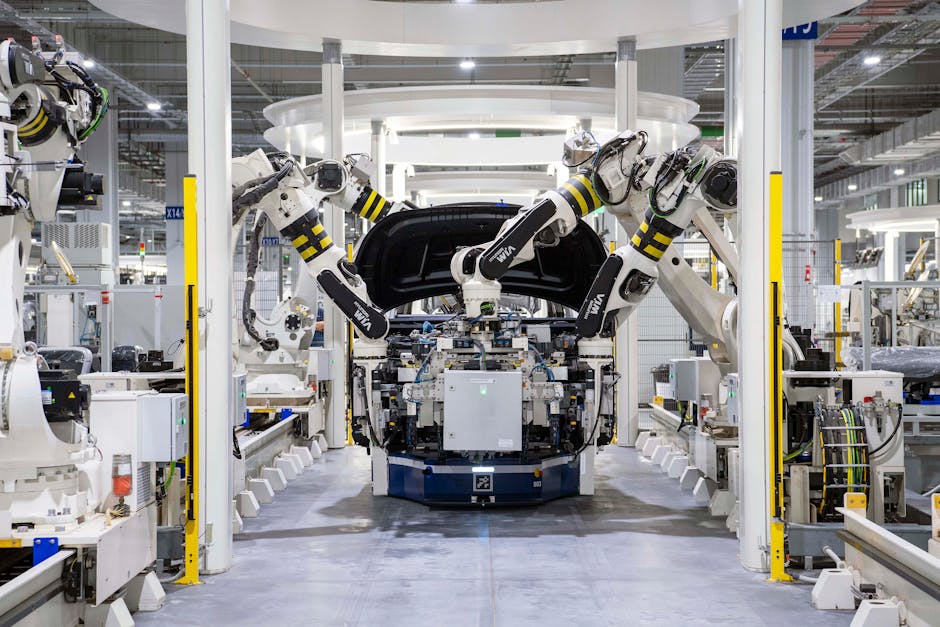Nanotechnology in Manufacturing: Revolutionising Materials and Processes
As you explore the world of modern manufacturing, you’ll find that nanotechnology is revolutionising the industry by introducing innovative materials and processes that are transforming the way products are designed, developed, and produced. Nanomaterials with enhanced properties, self-healing materials, and water-repellant surfaces are redefining manufacturing standards. Precision engineering and advanced material synthesis enable the creation of complex structures and devices with nanoscale accuracy. In addition, nanotechnology optimises energy storage systems, reduces environmental impact, and increases energy conversion rates. As you continue to explore the fusion of nanotechnology and manufacturing, you’ll uncover even more groundbreaking innovations that are reshaping the industry’s future.
Key Takeaways
• Nanotechnology enhances material properties, such as strength, thermal resistance, and optical properties, through tailored nanoparticles and surface chemistry.• Effective supply chain management is critical to minimise lead times, reduce costs, and improve product quality in nanomaterial sourcing.• Self-healing materials with microcapsules can autonomously repair cracks and damages, reducing waste and environmental impact in manufacturing.• Advanced manufacturing techniques, like precision engineering, enable the fabrication of complex structures and devices with nanoscale accuracy and reduced defects.• Nanotechnology optimises energy storage systems through advanced thermoelectric materials, nanostructured devices, and enhanced energy conversion rates.
Nanomaterials in Modern Manufacturing

In modern manufacturing, you’re likely to encounter a plethora of nanomaterials that have revolutionised the industry with their unique properties and applications.
These materials, with their nanoscale dimensions, have opened up new avenues for innovation and improvement in various manufacturing processes. As you explore deeper into the world of nanomaterials, you’ll realise that sourcing these materials is a pivotal aspect of modern manufacturing.
Material sourcing is a fundamental component of the supply chain, and it’s imperative to facilitate an efficient, reliable, and sustainable sourcing process.
You’ll need to weigh factors such as cost, quality, and availability when selecting nanomaterials for your manufacturing process. A robust supply chain is indispensable to guaranty a steady supply of high-quality nanomaterials, and manufacturers must establish strong relationships with suppliers to mitigate risks and guaranty business continuity.
When it comes to supply chains, you’ll need to examine the entire value chain, from raw material extraction to end-product delivery.
This includes managing inventory, logistics, and distribution networks. Effective supply chain management is critical to minimise lead times, reduce costs, and improve product quality.
Enhanced Material Properties

As you explore the application of nanotechnology in manufacturing, you’ll discover that it enables the creation of materials with enhanced properties.
Specifically, you’ll find that nanomaterials exhibit stronger material bonds, increased thermal resistance, and enhanced optical properties.
Stronger Material Bonds
You can engineer stronger material bonds by tailoring the surface chemistry of nanoparticles to optimise their interaction with surrounding materials. This allows for enhanced bond formation, which is essential for material integrity.
By manipulating the surface properties of nanoparticles, you can create strong bonds between the nanoparticles and the surrounding material, resulting in improved material properties.
Some key benefits of stronger material bonds include:
-
Improved mechanical properties: Enhanced bond formation leads to increased strength, toughness, and resistance to deformation.
-
Enhanced durability: Stronger bonds reduce the likelihood of material degradation and failure.
-
Increased resistance to corrosion: By optimising the surface chemistry of nanoparticles, you can reduce the risk of corrosion and material degradation.
-
Improved thermal and electrical conductivity: Stronger bonds enable more efficient heat and electrical conduction, leading to improved material performance.
Increased Thermal Resistance
As you explore the domain of nanotechnology in manufacturing, you’ll discover the significant impact of tailored nanoparticles on thermal resistance. Tailored nanoparticles with optimised surface chemistry can substantially enhance thermal resistance, thereby reducing heat transfer and enabling the creation of materials with improved thermal insulation properties. This breakthrough has far-reaching implications for various industries, particularly in the development of heat shields and thermal barriers.
| Material | Thermal Resistance (°C/W) |
|---|---|
| Traditional Insulation | 0.05 |
| Nanoparticle-Enhanced Insulation | 0.15 |
| Heat Shield (Aerogel) | 0.25 |
| Thermal Barrier (Graphene) | 0.35 |
| Advanced Nanocomposite | 0.45 |
The incorporation of nanoparticles into materials has led to remarkable improvements in thermal resistance. The table above illustrates the significant enhancements achieved through the use of nanoparticles, with advanced nanocomposites exhibiting thermal resistance values up to 0.45 °C/W. These advancements pave the way for the development of more efficient heat shields and thermal barriers, revolutionising various industries, from aerospace to construction.
Enhanced Optical Properties
By integrating nanoparticles into materials, you can tap unprecedented control over optical properties, such as refraction, absorption, and transmission, leading to breakthroughs in applications like optoelectronics and biomedical imaging.
This level of control enables you to manipulate light in ways previously impossible, opening up new avenues for innovation.
Some exciting possibilities include:
Tuneable refractive indices: By adjusting nanoparticle concentrations, you can fine-tune material refractive indices to optimise optical performance.
Enhanced luminescence: Quantum dots, for instance, can be designed to emit light at specific wavelengths, revolutionising biomedical imaging and optoelectronic devices.
Advanced light manipulation: Nanoparticles can be engineered to scatter or absorb light in specific ways, enabling novel applications like optical sensing and cloaking.
Ultra-sensitive detection: Nanoparticle-enhanced materials can be designed to detect minute changes in light intensity, paving the way for breakthroughs in fields like biomedical diagnostics.
Self-Healing Materials in Action

Researchers are currently developing self-healing materials that can repair cracks and damages autonomously, potentially revolutionising the manufacturing industry.
As you explore the potential of nanotechnology in manufacturing, you’ll discover how self-healing materials can substantially enhance material durability. By integrating microcapsules containing healing agents into the material, you can create a system that detects and responds to damage in real-time. This means that when a crack forms, the microcapsules rupture, releasing the healing agent to seal the crack and restore the material’s integrity.
The implications of self-healing materials are far-reaching, particularly when it comes to human safety. Imagine a world where aircraft, vehicles, or even medical devices can repair themselves in real-time, reducing the risk of catastrophic failures and ensuring the safety of users. By eliminating the need for frequent replacements and repairs, self-healing materials can also reduce waste and minimise environmental impact.
As you venture deeper into the world of self-healing materials, you’ll uncover the vast potential for applications in various industries. From aerospace to healthcare, the possibilities for self-healing materials to transform manufacturing are vast. With the continued development of this technology, you can expect to see substantial advancements in material durability, human safety, and environmental sustainability.
Water-Repellant Surfaces Explained

You can now explore another groundbreaking application of nanotechnology in manufacturing: water-repellant surfaces, which have been engineered to exhibit exceptional hydrophobic properties, opening up new possibilities for innovative product design and functionality.
These surfaces are designed to minimise the interaction between the material and water, reducing the surface tension and resulting in a self-cleaning effect. This phenomenon is often referred to as the Lotus Effect, named after the self-cleaning properties of the lotus leaf.
The exceptional water-repellant properties of these surfaces can be attributed to the unique nanoscale structures and textures engineered onto the material. These structures create a high degree of surface roughness, which reduces the contact area between the material and water, resulting in a significant decrease in surface tension.
Some key characteristics of water-repellant surfaces include:
-
High contact angles: Water droplets on these surfaces exhibit high contact angles, indicating a high degree of hydrophobicity.
-
Low sliding angles: Water droplets on these surfaces can easily slide off, reducing the risk of water accumulation and contamination.
-
Self-cleaning properties: The Lotus Effect enables these surfaces to self-clean, reducing the need for maintenance and cleaning.
-
Enhanced durability: Water-repellant surfaces can withstand harsh environmental conditions, reducing the risk of material degradation.
Precision Engineering at Scale

At the nanoscale, precision engineering enables the fabrication of complex structures and devices with unprecedented accuracy, allowing for the mass production of intricate components with tolerances measured in mere nanometres.
As you explore the domain of nanotechnology, you’ll discover that precision engineering is essential for achieving the desired properties in materials and devices. To achieve this level of precision, machine calibration is pivotal. You need to confirm that your machines are calibrated to exacting standards, allowing for the precise manipulation of materials at the nanoscale.
Tolerancing standards also play a paramount role in precision engineering. By establishing strict tolerancing standards, you can guaranty that your components meet the required specifications, verifying that they function as intended. This is particularly important in applications where even the slightest deviation can have significant consequences.
For instance, in the production of nanoscale sensors, a deviation of just a few nanometres can affect the sensor’s performance. By adhering to strict tolerancing standards, you can minimise the risk of defects and verify that your components meet the required specifications.
As you venture deeper into the world of precision engineering, you’ll realise that it’s not just about achieving precision, but also about maintaining it. This requires a deep understanding of the underlying principles, as well as the ability to adapt to changing conditions.
Streamlined Production Processes

By integrating nanotechnology into manufacturing, production processes can be substantially streamlined, enabling companies to reduce waste, minimise defects, and increase productivity.
This is achieved through the implementation of advanced process automation, which enables real-time monitoring and control of production lines. As a result, you can identify and rectify issues promptly, reducing downtime and increasing overall efficiency.
By leveraging nanotechnology, you can optimise production planning and inventory management, ensuring that resources are allocated effectively and minimising the risk of stockouts or overstocking.
Implement quality control measures that can detect even the slightest deviations in product quality, enabling swift corrective action to be taken.
Streamline supply chain operations, reducing logistics costs and lead times through the use of nano-enabled packaging and tracking technologies.
Achieve significant cost reductions through the elimination of waste, reduced energy consumption, and extended equipment lifespan.
Advanced Material Synthesis

As you explore advanced material synthesis, you’ll discover the significance of nanostructured material design in creating high-performance materials with tailored properties.
By engineering materials at the nanoscale, you can achieve enhanced strength, conductivity, and optical properties, leading to breakthroughs in various industries.
You’ll learn how to manipulate material structures to tap unprecedented performance capabilities.
Nanostructured Material Design
You design nanostructured materials by manipulating their internal structure at the nanoscale to achieve unique properties not found in their bulk counterparts. This precise control over material architecture enables the creation of materials with tailored properties, such as enhanced strength, conductivity, or optical properties.
To achieve this, you leverage advanced computational frameworks and materials informatics tools to simulate and predict the behaviour of materials at the nanoscale.
Some of the key considerations in nanostructured material design include:
Material composition: Selecting the ideal material components and their ratios to achieve desired properties.
Nanostructure geometry: Designing the internal structure of the material, including the size, shape, and arrangement of nanoparticles or nanostructures.
Interfacial interactions: Controlling the interactions between nanoparticles or nanostructures and their surroundings to optimise material performance.
Scalability: Ensuring that the material design can be scaled up from laboratory synthesis to industrial production.
High-Performance Material Properties
Through the precise control of nanostructured material design, you can now create high-performance materials with tailored properties, such as exceptional strength, conductivity, or optical properties, by leveraging advanced material synthesis techniques.
This enables you to optimise material durability, a critical factor in various industries, including aerospace, automotive, and energy.
By fine-tuning material structures at the nanoscale, you can achieve property optimisation, resulting in enhanced performance, efficiency, and sustainability.
Advanced material synthesis techniques, such as molecular beam epitaxy, atomic layer deposition, and 3D printing, allow you to engineer materials with specific properties.
For instance, you can design materials with high thermal conductivity for efficient heat management or materials with tailored optical properties for advanced sensing applications.
Additionally, you can create materials with enhanced mechanical properties, such as strength, toughness, and fatigue resistance, for demanding industrial applications.
The Future of 3D Printing

Rapid advancements in nanotechnology are poised to revolutionise 3D printing, enabling the creation of complex structures and materials with unprecedented precision and accuracy. As you explore the future of 3D printing, you’ll discover the potential to transform industries and revolutionise manufacturing processes.
One of the most promising areas of research is in the development of printed organs. Imagine being able to print functional organs for transplantation, revolutionising the field of organ donation and transplantation. However, this raises concerns about cybersecurity risks, as the use of 3D printing in healthcare increases the risk of cyber attacks on sensitive medical data.
As you look to the future of 3D printing, consider the following advancements:
Nano-scale 3D printing: enabling the creation of complex structures with unprecedented precision and accuracy
Bioprinting: printing functional organs and tissues for medical research and transplantation
Smart materials: developing materials that can adapt to changing environments and respond to stimuluses
Cyber-physical systems: integrating 3D printing with artificial intelligence and IoT to create autonomous manufacturing systems
As you explore the future of 3D printing, you’ll realise the vast potential for innovation and transformation in various industries. With the rapid advancement of nanotechnology, the possibilities for 3D printing are endless, and the future looks brighter than ever.
Efficient Energy Harvesting

As you explore the domain of efficient energy harvesting, you’ll discover that nanotechnology plays a vital role in optimising energy storage systems, creating advanced thermoelectric materials, and designing nanostructured devices.
These innovations have the potential to substantially enhance energy conversion rates and reduce energy losses.
Energy Storage Systems
You can substantially improve the performance of energy storage systems by incorporating nanotechnology-based materials that enable efficient energy harvesting. By leveraging nanomaterials, you can enhance the power density and overall efficiency of energy storage systems. This is particularly important for applications that require high-performance energy storage, such as electric vehicles or renewable energy systems.
Some key benefits of nanotechnology-based energy storage systems include:
-
Improved Battery Management: Nanomaterials can enhance battery performance by increasing the surface area, allowing for more efficient charging and discharging.
-
Increased Power Density: Nanomaterials can facilitate higher power density, enabling faster charging and discharging rates.
-
Enhanced Energy Storage Capacity: Nanomaterials can increase the energy storage capacity of batteries, allowing for longer battery life and improved overall performance.
-
Reduced Weight and Size: Nanomaterials can reduce the weight and size of energy storage systems, making them more suitable for portable or imbedded applications.
Advanced Thermoelectric Materials
What makes advanced thermoelectric materials a game-changer in efficient energy harvesting is their ability to convert waste heat into electrical energy with unprecedented efficiency.
You’re likely familiar with the concept of thermoelectricity, where a temperature difference generates an electric potential. However, traditional thermoelectric materials have limited thermal efficiency, restricting their applications.
Advanced thermoelectric materials, on the other hand, boast remarkably higher energy conversion rates, making them a breakthrough in efficient energy harvesting.
These materials’ enhanced thermal efficiency stems from their unique nanostructures, which increase the Seebeck coefficient and reduce thermal conductivity.
As a result, they can efficiently convert waste heat from various sources, such as industrial processes, vehicles, or even the human body, into useable electricity.
This technology has far-reaching implications, enabling the development of sustainable, wearable power sources, more efficient industrial processes, and even self-sustaining devices.
Nanostructured Devices
By harnessing the unique properties of advanced thermoelectric materials, researchers have developed nanostructured devices that can efficiently harvest energy from waste heat, offering a promising solution for powering small-scale devices and systems.
As you explore the domain of nanostructured devices, you’ll discover that they’ve the potential to revolutionise the way we think about energy harvesting.
Some key features of these devices include:
Enhanced thermoelectric performance: By tailoring the nanostructure of materials, researchers can substantially improve their thermoelectric efficiency, allowing for more effective energy harvesting.
Cellular interactions: The nanoscale dimensions of these devices enable them to interact with cells in ways that were previously impossible, opening up new avenues for bio-inspired energy harvesting.
Quantum tunnelling: The unique properties of nanostructured materials enable quantum tunnelling, allowing for more efficient energy transfer and increased power output.
Scalability: These devices can be easily integrated into existing systems, making them a viable solution for powering small-scale devices and systems.
As you plunge deeper into the world of nanostructured devices, you’ll begin to appreciate the vast potential they hold for transforming the way we approach energy harvesting.
Environmental Impact Reduction

Nanotechnology’s potential to minimise environmental degradation lies in its ability to reduce waste and emissions throughout the manufacturing process.
As you explore the role of nanotechnology in manufacturing, you’ll discover its significant impact on reducing the environmental footprint of production.
Waste Minimisation is a vital aspect of this reduction. Traditional manufacturing processes often generate substantial amounts of waste, which can harm the environment and increase production costs.
By leveraging nanotechnology, you can minimise waste by creating materials with precise properties, reducing the need for excess materials and scraps. This approach enables you to optimise production, reduce waste, and lower costs.
Another key area where nanotechnology makes a significant impact is in reducing the Carbon Footprint. Conventional manufacturing processes often rely on energy-intensive methods, contributing to greenhouse gas emissions and climate change.
Nanotechnology offers an alternative by enabling the development of more energy-efficient materials and processes. For instance, nanostructured materials can improve the efficiency of solar cells, reducing the carbon footprint of energy production.
Conclusion
As you gaze into the horizon of manufacturing’s future, a domain of unparallelled innovation unfolds.
The synergy of nanotechnology and advanced materials is poised to orchestrate a symphony of efficiency, precision, and sustainability.
The maestros of materials science are crafting a world where self-healing surfaces, precision-engineered structures, and efficient energy harvesting harmonise in perfect synchrony, beckoning a new era of responsible manufacturing.
Contact us to discuss our services now!
